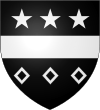Clan Leask
| Clan Leask | |||
|---|---|---|---|
 | |||
| Motto | Virtute Cresco (Lat. I grow by virtue)[1] | ||
| Profile | |||
| Region | Highlands | ||
| Chief | |||
 | |||
| Jonathan Leask of that Ilk | |||
| Chief of the Name and Arms of Leask | |||
| |||
| |||
Clan Leask is a Scottish clan.[2]
History
Origins
There are several possible origins of the surname Leask.[2] One possibility is that it is a diminutive of the Anglo-Saxon word lisse, which means happy.[2] In the Norse language it means a stirring fellow.[2] Professor Leask of Aberdeen believed that the ancestor of the Leaks was Liscus who was chief of the Haedui, a tribe of Gauls who were described by Julius Caesar during his Gallic Wars.[2] One of the greatest fortresses in France was the Castle of Boulogne, a possession of Charlemagne which at one time belonged to a family called de Lesque.[2] An early reference to the name is that of Erik Leask who was reputedly chamberlain to the king of Denmark.[2]
In 1296 William de Laskereske appears on the Ragman Rolls submitting to Edward I of England.[2] In about 1345 William Leask received a charter of confirmation to his lands of Leskgoroune or Leskgaranne from David II of Scotland, son of Robert the Bruce.[2] He might be the same William Leysk who was recorded in the parish records of the church at Ellon, Aberdeenshire as: William de Laysk, the elder, Lord of that Ilk, bequeathed a pound of wax yearly to the altar of the Holyrood in the church of St Mary of Ellon.[2]
In 1390 the second known chief of Clan Leask who was ballie of the barony of Findon, inherited half of the lands of Henry de Brogan, Lord of Achlowne.[2] He also appears as a witness to a charter by the Earl of Orkney in 1391.[2]
15th and 16th centuries
In the middle of the 15th century a younger son of Leask went to Orkney at the request of the earl, who had formed a court at Kirkwall Palace.[2] There a branch of the Clan Leask was formed which still shows the longest unbroken male lines of the clan.[2]
The third chief of Clan Leask, Wilfred, signed a bond of Manrent in favour of William Hay, Earl of Erroll in 1456 and also resigned his lands in favour of his son and heir.[2] From this point onwards the connection with the Clan Hay appears to have remained strong.[2] When the Cheynes of Esslemont allied themselves with the Hays their bond was signed at the Chapel of Laske in 1499.[2]
In 1574 following the deposition of Mary, Queen of Scots, William Leask, seventh chief of Clan Leask signed an oath of allegiance to the child James VI of Scotland.[2]
17th century
The register of the Privy Seal records that in 1615 a complaint was made from Alexander Leask that Adam Gordon, brother of the Laird of Gight, put violent hands upon him at the Yet of Leask, wounding him grievously.[2] Later that year the Gordons again attacked the Leasks, setting upon a son of the chief for which George Gordon was outlawed.[2] In 1616, William Leask of that Ilk was accosted by John Gordon of Ardlogy and a party of men with pistolets and hagbuts.[2]
In 1672 Alexander Leask of that Ilk was amongst the noblemen who recorded their coats of arms in a newly established public register.[2] Towards the end of the seventeenth century disaster overtook the family after they invested in the failed Darien scheme, a trading venture with Central America intended to rival the East India Company that had been established in London.[2] Alexander Leask of that Ilk, the thirteenth chief was forced to give up his estates which were taken over by Robert Cumming.[2]
The clan today
Little is known of the Clan Leask between the disaster of the late seventeenth century until 1963, when a descendant managed to buy back a portion of the family lands and established the Leask Society, with the support of other prominent Leasks. This includes Lieutenant General Sir Henry Leask, who was a governor of Edinburgh Castle and General Officer commanding the Army in Scotland.[2] In 1968 Moira Anne Helgesen was granted the chiefship of the clan by the Lord Lyon King of Arms,[2] whereupon she changed her name and became: Madam Anne Leask of Leask. She died in April 2008 and was succeeded in the chiefship of the clan by Jonathan Leask, who became the 23rd chief of Clan Leask.[3]
See also
References
- Clan Leask Profile scotclans.com. Retrieved 13 October 2013.
- Way, George and Squire, Romily. Collins Scottish Clan & Family Encyclopedia. (Foreword by The Rt Hon. The Earl of Elgin KT, Convenor, The Standing Council of Scottish Chiefs). Published in 1994. Pages 190 - 191.
- Obituary: Madam Anne Leask of Leask Archived 5 January 2009 at the Wayback Machine